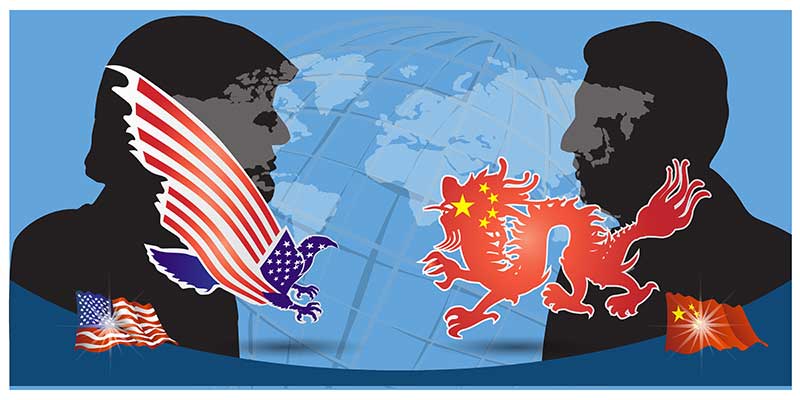September 12, 2019
Trump Delays Tariff Increase
The president has pushed back a planned heightened duty rate on $250 billion of Chinese imports by two weeks.
President Donald Trump said Wednesday that he will delay increasing the tariff rate on $250 billion worth of Chinese imports from the current 25% to 30% by two weeks.
Now, according to the president, the tariffs will go into effect on Oct. 15 instead of the previously planned Oct. 1.

Illustration of U.S. President Donald Trump and China President Xi Jinping.
The move comes ahead of scheduled face-to-face trade deal talks between high-level U.S. and China negotiators in Washington D.C. in October. It also occurs after China, on Wednesday, said that it was exempting 16 products from a list of retaliatory tariffs it’s imposing on U.S. imports in reaction to recent levies from Trump.
The U.S. president explained the tariff increase delay in tweets, saying it was a gesture of goodwill.
....on October 1st, we have agreed, as a gesture of good will, to move the increased Tariffs on 250 Billion Dollars worth of goods (25% to 30%), from October 1st to October 15th.
— Donald J. Trump (@realDonaldTrump) September 11, 2019
Beijing’s announced levy exemptions and Washington D.C.’s tariff escalation delay happened a couple days after U.S. Treasury Secretary Steven Mnuchin told reporters that the U.S. and China have a “conceptual agreement” related to enforcing the terms of a new trade deal between the world’s two largest national economies. Enforcement is a particularly key issue as it relates to what the U.S. side says is intellectual property theft by Beijing on American firms doing business in China.
The “conceptual agreement” and softening tone in the ongoing trade war created some optimism in markets. Early Thursday eastern U.S. time, global stocks were surging higher. For instance, the Shanghai Composite and Japan’s Nikkei were both up 0.8%, while the China A50 jumped 1.4%.
Despite the positive signs of recent days, analysts cautioned against putting too much faith in the idea that a trade deal between the U.S. and China is imminent.
“This is better than nothing," Michael Every, senior Asia-Pacific strategist at Rabobank, said in a research note in reference to Trump’s tariff delay. "Yet getting a real deal done from here within the parameters both sides have set will be akin to threading a needle on the back of a galloping horse wearing thick riding gloves.”
Neil Wilson, chief market analyst for Markets.com, expressed similar sentiments in a research note: “…This is mere posturing, albeit it at least means we look to these October high-level discussions with a bit more optimism.”
While hopeful for a new trade deal that will lead to a rollback or dissolution of tariffs, executives in the promotional products industry weren’t holding their breath.
“I don't believe the two-week delay will make a huge difference,” Shamini Peter, chief operating officer at Top 40 distributor Axis Promotions (asi/128263), told Counselor. “With big personalities, compromise and solution is going to be an uphill battle. We are continuing to advise our clients to take into account all additional tariffs and, if the trade talks don’t go great, there will be an additional amount in their invoices. No one has complained about this at all.”
David Nicholson, president of Top 40 supplier Polyconcept North America, told Counselor that he doesn’t expect a resolution during the October trade talks, but added that the tariff increase delay “was welcome news and a positive reversal of the escalating rhetoric over the last few weeks. With both sides making small but important concessions this week, this hopefully opens the door to a more productive dialogue during the upcoming October trade negotiations.”
Nicholson said he sees some additional positives in recent developments. “The other notable move was China’s suggestion to separate trade issues from national security issues during the upcoming negotiations,” Nicholson told Counselor. “This approach would allow for two parallel negotiation tracks – possibly enabling near-term agreements around trade while the more difficult security issues are tackled separately. We’ll see if the U.S. administration is open to this approach, but it does create the potential for more immediate progress.”
Meanwhile, Gregg Emmer, vice president and chief marketing officer at Top 40 distributor Kaeser & Blair (asi/238600), feels that, ultimately, the dispute will be settled and the duties wiped away. “I think we are watching the president’s negotiation style,” Emmer told Counselor. “I expect that eventually he will propose the elimination of all tariffs, and that’s what we’re leading up to.”
Despite the U.S.’s temporary delay on a steeper levy rate for some Chinese imports, new tariffs of 15% that went into effect on Sept. 1 on $112 billion worth of imported Chinese products remain in play. Combined with the soon-to-rise 25% tariff on the $250 billion in goods and the additional levies on more imports currently scheduled to go into effect on Dec. 15, virtually everything the U.S. buys from China will be subject to duties. That figures to drive up prices on a broad spectrum of consumer goods and promotional products in the months ahead.
The U.S./China trade war, which has escalated over the last couple years, has caused impacts on the American promotional products industry, which imports the vast majority of products sold stateside from China. Issues include increased product prices, destabilized annual pricing, challenges in producing catalogs, and an ever more uncertain selling environment. It’s also made longer-term planning more difficult for some suppliers and caused suppliers (and certain distributors that source direct from abroad) to increasingly look for countries beyond China to produce products. As the search for new sourcing destinations accelerates, some industry leaders worry that more product safety and social responsibility issues will arise.
